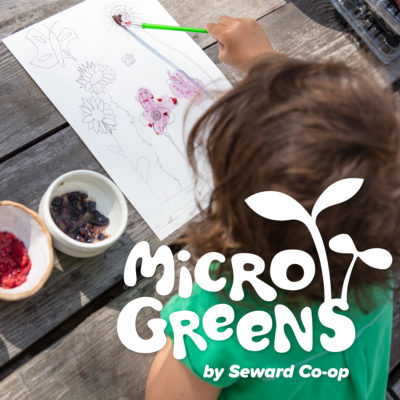Search Results
Get Creative this Valentine’s Day
Lots to Love at Seward Co-op
Valentine’s Day: Special Treats, Floral Wrapping
Make your Valentine’s Day special with Seward-made treats for your sweetie.
Seward Co-op’s bakery department crafts cupcakes and cake in house. This year, we’re offering:
•Chocolate cupcakes topped with chocolate-dipped strawberries
•Six-inch chocolate cake (both vegan and traditional)
Valentine’s Day is Thursday, Feb. 14.
Remember the flowers! We’ll be offering free floral wrapping at both stores 3-7 p.m., Feb. 14.
Recipe: Strawberry Rhubarb Mocktail with Kombucha
Cool off with a refreshing mocktail featuring GT’s Kombucha, La Croix and rhubarb from our friends at the Hmong American Farmers Association (on sale). Hooch your booch with our Strawberry Rhubarb Mocktail as a base. Recipe inspired by Recipe Redux.
Step 1: Make fruit syrup
3 stalks of Hmong American Farmers Association rhurbarb
3/4 container of strawberries
sweetener (we used ¼ cup turbinado sugar)
zest + juice of 1 lime
1/4 cup water
1 tsp. vanilla
Chop rhubarb and cut strawberries. Combine rhurbarb, sweetener, lime zest and juice, and water in a small saucepan. Simmer with the lid on for a few minutes. Once the fruit starts to reduce, remove the lid and simmer until the fruit is soft and mashable. Use a strainer to separate the juice from the mashed rhubarb and strawberry. Use the syrup for your mocktail. Use the leftover fruit like a compote on breakfasts or desserts.
Step 2: Mix your mocktail
Syrup
GT’s Kombucha (We used Lemonade)
Muddled strawberries
Lime juice
Ice
La Croix Pure Sparkling Water
Garnish (We used a lime slice)
Customize and mix to your liking, using your favorite GT’s Kombucha and La Croix flavors. Follow us on Facebook, Instagram or Twitter for inspiration. Enjoy!
Farm Table Dinner with York Farm & Rebel Soil
Seward Co-op Creamery Café may be a pit stop on your way to work or a go-to lunch or happy hour choice for your family. To many of us, it’s more than that. We’re happy to offer the Creamery Café as a space to learn about food by sharing experiences with those who bring it from the farm to the table.
Join us at the Seward Co-op Creamery Café for a dinner event on Tuesday, Sept. 26, from 6 to 8:30 p.m., featuring two farm partners just west of the metro area: York Farm (Hutchinson, Minn.) and Rebel Soil (Litchfield, Minn.). Farm owners Andy Cotter & Irene Genelin and Andy Temple & Aimee Haag—along with their certified-organic and sustainably grown produce—will be our special guests for the evening. Creamery Café staff are delighted to feature a variety of vegetables, fruits, greens and sprouts showcasing the season’s harvest. Beverage pairings from Indeed Brewing and Feral Kombucha are available for $15. Tickets are limited, so grab your seat at our “Farm Table” right away!
Follow the Seward Co-op and our Creamery Café on social media and visit our website for future opportunities to engage with local farmers, producers, and community members.
York Farm
World champion unicyclists turned second generation farmers Irene Genelin and Andy Cotter embarked on their farming adventure together in 2010. Andy’s family originally bought the farm in 1971. As the local food movement gained momentum and Andy became interested in balancing food production and sustainability, farming became appealing to the General Mills IT professional. In 2002, Andy bought the farm for his residence. Today, York Farm is in their eighth season and has a dozen acres filled with rows of certified-organic grapes, strawberries, apples, plums, pears, currants, gooseberries, apricots, and Arctic kiwi.
Rebel Soil
Rebel Soil’s farming practices “rebel” against modern agricultural methods dependent on harmful chemicals, cheap labor and heavy machinery. Aimee and Andy vow to grow healthful, freshly harvested produce free of harmful pesticides, herbicides, or fertilizers. Farming on their small, four-acre farm in Litchfield provides them with daily opportunities to do more than simply grow produce, the couple also advocates for increased access to clean food, a healthier environment and stronger community ties.
Food Preservation 101: Freezing
Come September, Minnesotans don’t usually like to talk about freezing — unless we’re talking about thawing brats or making ice for another cool beverage in the back yard. But late summer and early fall is the season to gather and preserve fresh produce items for the upcoming wintry months. Below you’ll learn the best veggies and fruits to freeze so you can assemble a delicious stash for winter. For simplicity and speed, it’s tough to beat freezing for preserving the local harvest. Plus, you probably already have all the tools you need to get started — just stop by the co-op and pick up your produce.
Most vegetables will need to be blanched before freezing to cleanse the surface of dirt and organisms and stop the enzymes that reduce flavor. Follow the recommended blanching times from the National Center of Food Preservation on the right (image is below). Shave blanched sweet corn at its prime into freezer bags to use for the perfect side dish this Thanksgiving. Freeze tomatoes whole, separated from one another on a cookie sheet. Come New Year’s Eve or Super Bowl Sunday, when you’re ready to make a very special salsa or chili, thaw, slide the skins right off and prep, as needed.
It may be tempting to simply leave fruit as is and freeze, but the best practice is to prep the fruit for how you intend to use it. Otherwise you could end up with a solid undistinguishable fruit brick. Begin by washing and drying the fruit. Once apples and pears are peeled and cored, pits are removed from stone fruits, strawberries are hulled, and the rinds are removed from melons freeze in a single layer on a baking sheet. For later use in Thanksgiving pies, chunks or wedges work best. A rough chop for back-to-school smoothies is great. When the fresh fruit season seems too far away, you’ll be thankful for the frozen summer fruit morsels tucked away in the freezer.
How to $ave
Did you know we offer discounts on case quantities ordered in advance — 10 percent off for owners and 5 percent off for non-owners. Another tip for saving money on bulk purchases is to stock up on sale items. Some of the best deals are on Fridays during #FarmFreshFridays, when three to five produce items are on sale for 25 percent off. Follow us on social media for #FarmFreshFridays deals.
Tips:
- Start with the freshest produce possible.
- Portion vegetables into individual portions and store in a larger bag so you can just grab what you need when you need it.
- To freeze herbs, either blend in olive oil or place in water and freeze in ice cube trays.
- Build your own smoothie pack recipe for the perfect back-to-school breakfast: 2–3 cups fruit, 1 cup greens (optional). Add 1 cup of liquid (water, coconut water, juice, milk) then blend.
- Work fast, as defrosted fruit will stick together once frozen resulting in a giant ice block.
- Boost your smoothie’s nutrition by adding chia or flax seeds.
- Freeze yogurt in ice cube trays to add to smoothie packs.
Two-ingredient Pancakes
Nourish Recipe: Two-Ingredient Pancakes
Eating healthfully and affordably can be challenging. Whether you have budget constraints or are just looking for ways to save on your grocery bill, Nourish offers something for everyone. These simple, protein-packed, wheat-free pancakes taste amazing — and they will feed four people for under $10.
Two-Ingredient Pancakes
Ingredients per person:
4 bananas
8 eggs
Method:
Mash up bananas in a large bowl.
Whisk eggs and add to banana paste. Alternately, you can blend eggs and bananas in a food processor.
Fry in a pan with a little heated oil or butter like you would a regular pancake.
Serves 4
Feel free to mix in or top these pancakes with other ingredients from your pantry. Here are some suggestions:
For the batter:
1 Tbsp. cocoa powder
Small handful of nuts
1 Tbsp. raisins
1 tsp. cinnamon
Small handful of cubed apples or pears
Topping ideas:
Honey
Maple syrup
Cherries, strawberries
Yogurt
Sugar and lemon juice
Produce at its Peak: Poetry from Plums
I heard a couple of days ago via the radio newscast, that, because of the chilly spring, Minnesota’s strawberry crop has been quite delayed.
Indeed. By my calculations, we’re maybe two weeks behind schedule, but we did get a good supply in from Hoch Orchard this week. Hallelujah-there is really nothing like local berries. Fragrant and tender but very fragile, you really have to eat them the same day you buy them or they suffer. Local strawberries, almost more than any other crop, reflect the weather. They need sun and dry conditions as they ripen to be at their sweetest. Too much rain and they turn too soft and the flavor is diluted. Not enough sun and they tend towards tartness. This first flush is slightly on the tart side, so one suggestion is to melt a pat of butter in a pan and sautee them for a moment with a sprinkle of turbinado sugar.
Francique Mangoes (left) are unique fruits, both in flavor and in origin. They are oblong and somewhat flattened, green to yellow skinned, with a superlatively juicy, brilliant yellow-orange flesh. They come from Haiti, often from farmers that may have just a single tree to harvest. By pooling their crop, those farmers can accumulate enough supply to make it worth it to ship to the US. The color of the skin does not necessarily reflect the ripeness of the fruit, so ask a produce worker to help you pick a good one if you have any doubt. I believe they are the only item in the store that comes from the island of Haiti. This American Life has an interesting story from a few years about Haiti and mangoes.
Lettuce is not something that most people think much about, but starting now and for the next month or so, you really should try some of the local lettuces. Sourcing from local farmers really expands the varieties that we can stock. While California sends us the four basics: Romaine, Green Leaf, Red Leaf and, if we’re lucky, Butter, Farms like HeartBeet, Keewaydin, and Featherstone can grow such poetically named varieties as Black Seeded Simpson, Marvel of Four Seasons, Salanova and Red Sails. As it would create quite a labeling hassle, we don’t generally include the variety names on our signs, but you will notice a distinct flavor and texture difference when you buy local. One word of caution-this lettuce tends to harbor dirt and no one likes a gritty salad. As soon as you get it home, pull the leaves apart and submerge them in water four fifteen minutes or so. Swish vigorously and then spin or pat dry. I like to store my prepped salad greens in the salad spinner and use them as I need them.
This week also saw the first appearance of local kale. In particular, we love the Red Russian Variety, which is green with a violet cast to the leaves and stem. It is tender and not at all bitter, and makes for good eating raw or cooked. Lately I have been enjoying a salad made with a julienned Gala apple, toasted walnuts and two torn up leaves of Red Russian with a nice shallot vinaigrette. Although Green, Dino or Red Kale could take the place of Red Russian, the latter will always be my preference in this application.
It seems that in the summer, stone fruit should always be recommended. Nearly all varieties are spectacular right now. But cherries and black plums are my current favorites. I come from a family of fruit lovers. Our summer picnics always included a bag of fat Bing cherries and my mom bought a huge bag of plums every week, which my sisters and I devoured almost immediately. The Red Raven plums we have right now, dusky on the outside, and ruby red inside, deserve this very popular poem (as did my mother, all those years ago):
This Is Just To Say
William Carlos Williams, 1883 – 1963
I have eaten
the plums
that were in
the icebox
and which
you were probably
saving
for breakfast
Forgive me
they were delicious
so sweet
and so cold
Produce at its Peak
Wednesday, April 9, 2014 –Today, it is 70 degrees outside and sunny, and there is no snow in the ten-day forecast.
Surely, that means that it really is early Spring, which is one of the most challenging and interesting times of the year to work in a produce department like Seward’s. Transition and gap are key words. We’re transitioning from one growing region to another, which can mean gaps in availability.
For instance, the Braeburn apples from Washington that had been in storage since their harvest in the fall have run out, and we won’t have them in again until the South American harvests start to be shipped north, probably mid to late April. If you count back six months from April, you come to October, which is just about when the fresh crop of WA Braeburns was newly available. Makes sense-Chile and Argentina’s seasons are opposite of ours. So, if you’re a die hard Braeburn fan, you’ll be able to get them soon, and in the meantime, there are still lots of other apples available from Washington. Lady Alice has been particularly well loved by the produce stockers this year.
Pear season has been over in the northern hemisphere for six months or so, which means we’ve got the South American crop coming in now. The red Bartletts seem especially soft and luscious at the moment. They are mild, to be sure, but they go well with cheese or walnuts, and are sure to please little children.
Transition and gap isn’t just for fruit-if you’ve been in recently looking for red onions, you’ve likely been disappointed. The storage onion supply from the west coast is clearly dwindling, and they just don’t have enough reds to ship. Local red onions are long gone. But take heart-in the wet rack (top picture, above), you will often find red spring onions. Not to be confused with scallions or green onions, these are simply young, green harvested red onions. If they’d been left in the field they would eventually become the storage onions that you usually see in the root rack. I take the presence of such onions to mean that the onion fields of the west coast are yielding, and we’ll get some in due time. It’s likely that the first shipment of storage reds will come from Mexico, where it is already summer.
There was hardly a gap at all this year between the Wisconsin Growers parsnips that were harvested and stored in the fall and the overwintered ones from the same farms. Parsnips have the lovely quality of being unharmed, and in fact improved, by remaining unharvested in the ground for the winter. The cold makes them sweeter. They have been cleaned thoroughly by the growers, and are creamy white. In my opinion, they are best roasted, but they can also be shredded in potato pancakes or hashbrowns for an interesting variation.
There is a triad of items that will always mean Spring: Living waters English cucumbers, CA fava beans and really tasty berries. We’ve had Living Waters tomatoes for a while now, but the cucumbers come a little later. They are tender and sweet and need no peeling. In fact, to peel an English cucumber is to miss out on a part of the enjoyment of them.
Fava Beans are an unusual bean. Most beans like warm soils, but favas thrive in cool conditions, which is what brings them to market so soon in the year. To eat them, first remove the beans from the large, leathery pod, and then steam them for a few minutes. Heap them in a bowl and eat them with a pecorino or queso fresco, as a snack. The skin of the bean is usually best removed, making them a good finger food to leisurely enjoy with a friend on the picnic table. A glass of white wine would not be a bad idea either.
Berries start to come into season at this time of year, and while Strawberries are a steady occupant of the produce shelves, if you happen to be here on a day when Blackberries are in, you should treat yourself. They should be large and shiny and look as if they are about to burst that dark juice all over the package. If you manage not to eat them all out of hand, throw them in muffins or pancakes, or delicately add them to a fruit salad at the last minute.
Citrus is still good, although it will be transitioning out of season in the next couple of months. The Temple oranges are amazing-they remind me of orange popsicles in the best possible way. They have lots and lots of seeds, which can be a drawback, but they are good candidates for juicing, eliminating that nuisance.


